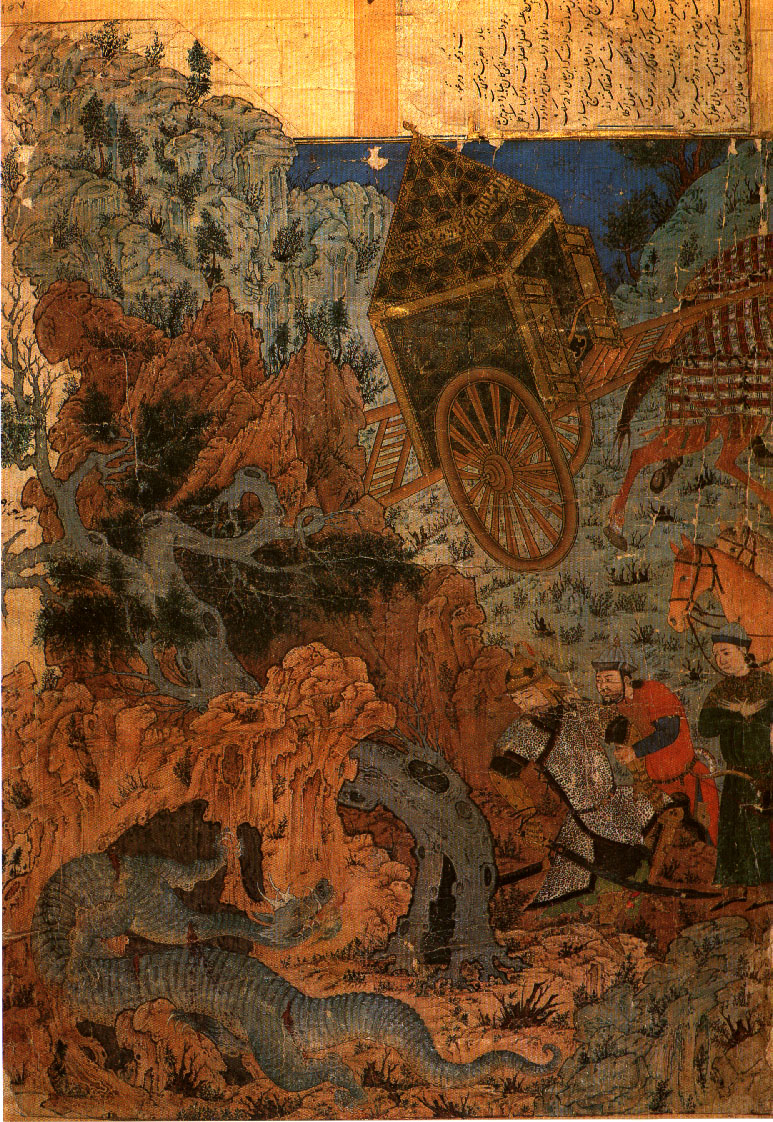Isfandiyar's third labour: he fights the dragon
Illustrations of Jalayrids from a late 14th Century Shahnama

From the Sarai Albums. Tabriz, second half of 14th century, Hazine 2153, folio 157a Topkapi Sarai Museum.

Isfandiyar fights with the Dragon
Shah-nama.
From the Sarai Albums
Tabriz, second half of 14th century
Hazine 2153, folio 157a
Source: Mongols and Painting under the Jala'ir
Isfandiyār Killing the Dragon; Third Stage (fig. 18).
Isfandiyārís guide on his journey to Turan following a route of seven stages is his prisoner, Gurgsār, who tells him that he is going to encounter a dragon on the third stage. Isfandiyār has a carriage built from which swords protrude, and he rides in it towards the dragon. The dragon tries to overthrow the carriage and the horses and is badly wounded by the swords in the process. Isfandiyār comes out of the carriage and kills the dragon, which has been weakened by the loss of blood. Isfandiyār falls on his knees and thanks God for his help.
The incident takes place in a magnificent setting. The rocks rising on the left have been painted in two shades of pink-beige. Before the rocks is the bleeding dragon painted blue-grey. A twisting tree trunk bends towards the left. The trunk is grey, and its small leaves are grey-green. On the right Isfandiyār kneels, and behind him stand his men. He wears a gown of animal skin and a gold helmet, and he is in the process of sheathing his sword. Above him, in the background is the carriage with a side view of the rear half of the horses. The carriage itself is very delicately decorated with gold on dark-grey, and its top is pyramid-shaped. An inscription in Arabic encircles the pyramid. The blue-grey ground on which the carriage and the figures have been placed is decorated with dark-green plant motifs. The rocks on the left rise beyond the frame of the miniature.
The splendor of nature suggests that the narration of the event has been relegated into the background. A large portion of the miniature, devoted to a portrayal of nature, exhibits great care and skill in every detail. The use of various shades of the same color has given depth to the painting. An interesting aspect of the incident itself is that instead of one single moment three different moments of the encounter are depicted: the carriage and horses above give us the moment before the clash; below we see the dragon, wounded in four places, ready to attack Isfandiyār; Isfandiyār is shown sheathing his sword before he falls prostrate on the ground to thank God. The mass of rock on the left, the bent tree trunk, and the dragon, which looks as if it were part of the rock mass, balances the carriage and figures on the right.
Text source: "Four Istanbul Albums and Some Fragments from Fourteenth-Century Shah-Namehs" by Nurhan Atasoy, pp. 19-48 in Ars orientalis; the arts of Islam and the East Vol. 8 (1970)